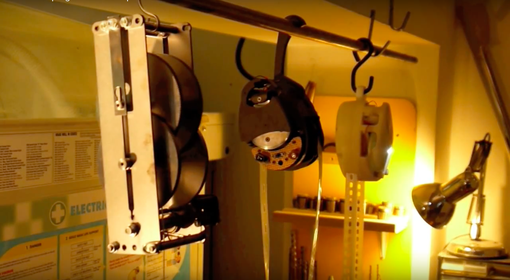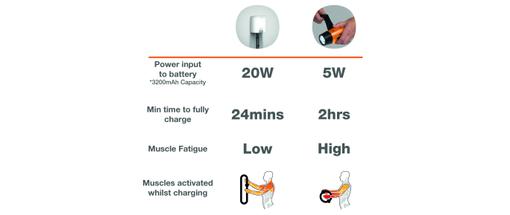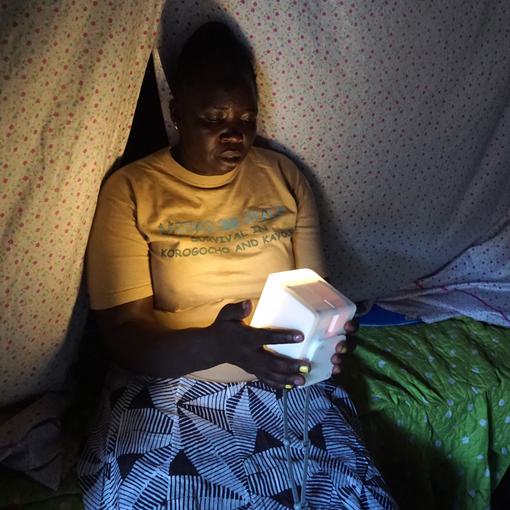nowlight – renewable power, anytime and anywhere

Uncategorised
At times, it may appear to some that innovative technologies and products tend to spring up out of the blue – that the innovator in question woke up one morning and engineered a working product by nightfall. In rare cases, this is (more or less) the case. However, more often than not the truth is that the innovative technologies we see in the news were developed rather more meticulously – the result of continuous iterative processes that significantly transform a product from its original concept. ‘nowlight’, a renewable energy solution produced by company Deciwatt, is one such example – generating instant on-demand power independent of the weather.
nowlight – a journey of engineering through ideation, iterative product development, in-depth user research, and a pivot.
In sub-Saharan Africa, two out of every three people are without access to electricity [Energy Africa, DFID]. Globally, over a billion people are ‘off-grid’; millions more live with unreliable supply. Without consistent access to electricity, the majority of families living on less than $3 a day have to rely on kerosene lamps for light. Not only do these lamps consume up to 20% of household income, cause eye and respiratory diseases, and risk burns and fires – but each lamp also emits 370kg CO2e p/a [GOGLA].In 2009, UK charity SolarAid highlighted this reality to two designers, Martin Riddiford and Jim Reeves, who then started to consider ways to develop sustainable, low-cost alternatives to kerosene lamps.
A lightbulb moment
At this time a nascent industry existed for solar lanterns, however, their photovoltaic (PV) panels and batteries comprised over 60% of their cost, with little room to reduce this significantly. With the brief to develop a lower-cost solution, Martin and Jim decided to look beyond solar and battery-powered devices – looking to leverage an even more ubiquitous energy source: human power. This led to the invention of GravityLight – an off-grid light powered by the lift of a weight.
How it works: The Basics
A weighted bag, connected to GravityLight, is lifted by the user. Then, as it gradually descends, it turns a gear train, which drives the motor that powers the LEDs. It takes a couple of seconds to lift the weight but powers GravityLight for 20 minutes of light during its descent. In this way, GravityLight generates instant power and does so independently of the sun with no need for batteries.

How it works: The Detail
GravityLight works by transforming the pull of gravity into electricity. The potential energy of a raised weight is turned into kinetic energy as the weight descends and turns a gear train. The gears power a generator, turning mechanical energy into electricity that powers an LED (light-emitting diode).
To provide it with sufficient room to descend, GravityLight is installed at around 6ft/1.8m from the ground. The bag is filled with 12kg of weight – such as rocks or sand – and lifted with a pulley system that reduces the pull force to 3kg.
As the weight gradually descends (a rate of about 1mm per second), it turns a drive sprocket at high torque (force) and low speed. This sprocket then drives a gear train to increase the speed and decrease the torque (force) which, in turn, drives a DC generator – a motor running backwards – at 1600RPM.
In this way, GravityLight generates just under a deciwatt (0.1 watt) of electricity, which powers the LEDs to create light.
Why hasn’t a GravityLight been made before?
Using the force of gravity and kinetic energy to create electricity is not a new idea.
What is new – and continually improving – is the efficiency of LED technology in turning electricity into light. The 0.1 watt produced by GravityLight equals 16 lumens of light – over 5 times brighter than a kerosene lamp. What’s more, LEDs are currently at about 30% efficiency; as they continue to improve, so too will the amount of light that GravityLight produces.
What stops the bag from falling fast to the floor?
The LEDs.
While the fastest gear runs at a high speed, it does so at such low torque (force) that even a small amount of resistance reduces the speed of the gear. Once the generator turns up to a certain speed – the voltage limit of the LED is reached. Once this happens, the back EMT in the generator prevents the gears from turning any faster. This means the weight falls at a slow, constant speed because the system is at equilibrium.

Crowd-powered
In November 2012 a working prototype was produced. From there, the concept needed to be tested in real-world environments, so we looked to crowdfunding to enable us to invest in the tooling, manufacture, and trial of GravityLights with off-grid families in Africa and Asia. We would then use the feedback produced by this endeavour to develop an improved model for large-scale production.
Round one
Within 30 days of launch, the crowdfunding campaign saw 6219 supporters raise over seven times the original target. Trial partners were also sourced from our crowdfunding community – collecting user feedback across 26 countries. The results were extremely encouraging, with over 90% of respondents saying they would use a GravityLight instead of a kerosene lamp.
However, the feedback also highlighted several improvements we needed to make before GravityLight could be a viable and reliable solution. Over the next two years, thanks to Innovate UK funding, we transformed the proposition through further product development, accelerated life testing, and iterative improvements – enhancing its longevity, ease of use, brightness, and duration.
Round two
Once more, we raised another $400k for the pilot of GravityLight ‘GL02’ in Kenya. For the pilot, we needed both a local, in-country team, as well as partnerships to test the commercial viability of GravityLight at scale and the optimum routes to market – gathering feedback from ‘early adopters’ throughout.
With support from Shell’s #MakeTheFuture campaign, the DOEN Foundation, and Comic Relief we reached over 2500 people. Through their feedback, we were then able to form the product specification and business model needed for sustainable scaling in the future
A Pivot
During the course of GravityLight’s development and trials, significant changes were underway in the solar industry, the mobile landscape, and in financial access for the ‘unbanked’. These changes, in turn, shifted the future we saw for the product. Today, mobile phones are used by 87% of the population in Kenya. Mobile money transactions, which continue to increase in popularity, are possible on even the most basic phones.
As such, it was unsurprising that the majority of GravityLight users also wanted it to charge a phone. In parallel, the advances in rechargeable lithium-ion battery technology and PV panels, combined with their continually decreasing costs, opened up several new opportunities to provide off-grid households with significantly more power.
With these changes in mind and the support of Innovate UK’s Energy Catalyst grant, we researched human power generation to optimise the biomechanical design of our solution. We also worked with international experts to select and test the ideal battery for fast-charge cycles, within tight-cost parameters.
The solution
After studying the ergonomics and efficiency of manual charging options, we realised that we needed to develop a hand-over-hand charging solution linked to a lithium-ion phosphate battery. By using larger muscle groups for power, we are able to input over 4x more power, over a longer period of time, with less fatigue (compared with traditional wind-up torches).
Across the UK and Kenya, we ran extensive user-testing and in-home trials with prototypes. These efforts were fundamental to the development of nowlight from its original concept into a production-ready device.

nowlight
Patent-pending, nowlight is a renewable energy solution that generates instant on-demand power independently of the weather. Just one minute of pulling generates over three hours of light at 10 lumens, and nowlight’s 3200 mAh battery can store over 120 hours of light (or recharge around 1.5 smartphone batteries).
Given that the majority of off-grid households are in sunny sub-Saharan Africa and Asia, and that millions ‘on-grid’ experience intermittent power, we wanted nowlight to be designed with 3 charging options for maximum flexibility. As well as manual charging for power anywhere, anytime, nowlight has an optional 3W solar panel to make the most of the sun, and a mains adaptor to charge up if/when electricity is available.

Looking forward
We are manufacturing our first production run in Q1 2019, which is projected to start aiding:
- Emerging Markets reaching off-grid households
- Humanitarian Relief Markets to NGOs supporting the 9 in 10 refugees in camps without access to electricity
- Emergency Preparedness Markets for households living at high risk of natural disasters and power cuts
- Outdoors Markets for camping and cabins – supporting us to reach off-grid families at a lower price point
Over the next four years, we project to reach at least 2 million people with clean, safe and reliable power – addressing Sustainable Development Goal 7 – and eliminating over 140k metric tonnes of CO2e.



